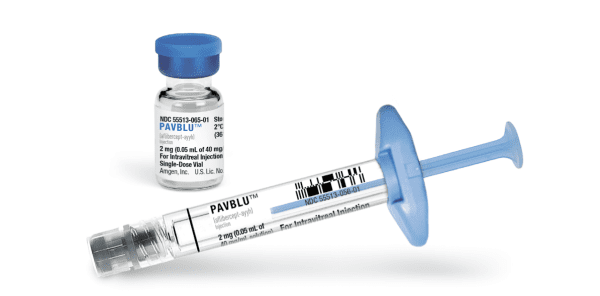Pavblu Side Effects
Generic name: aflibercept ophthalmic
Note: This document provides detailed information about Pavblu Side Effects associated with aflibercept ophthalmic. Some dosage forms listed on this page may not apply specifically to the brand name Pavblu.
Applies to aflibercept ophthalmic: intraocular solution.
Serious side effects of Pavblu
Along with its needed effects, aflibercept ophthalmic (the active ingredient contained in Pavblu) may cause some unwanted effects. Although not all of these side effects may occur, if they do occur they may need medical attention.
Check with your doctor or nurse immediately if any of the following side effects occur while taking aflibercept ophthalmic:
More common side effects
- blindness
- bloody eye
- blurred vision
- eye or eyelid redness
- eye pain
- seeing flashes, sparks of light, or a veil or curtain
- seeing floating spots before the eyes
- vision changes
Less common side effects
- bleeding or pain at the injection site
- swelling of the eyelid
Rare side effects
- chest tightness
- fast heartbeat
- fever
- headache
- hives, itching, rash, or skin redness
- hoarseness
- irritation
- joint pain, stiffness, or swelling
- swelling of the eye, face, lips, hands, or feet
- trouble breathing or swallowing
Incidence not known
- pain in the chest, groin, or legs, especially the calves
- severe, sudden headache
- slurred speech
- sudden loss of coordination
- sudden, severe weakness or numbness in the arm or leg
Other side effects of Pavblu
Some side effects of aflibercept ophthalmic may occur that usually do not need medical attention. These side effects may go away during treatment as your body adjusts to the medicine. Also, your health care professional may be able to tell you about ways to prevent or reduce some of these side effects.
Check with your health care professional if any of the following side effects continue or are bothersome or if you have any questions about them:
Less common side effects
- feeling like something is in the eye
- watery eyes
For healthcare professionals
Applies to aflibercept ophthalmic: intravitreal solution.
General adverse events
The more commonly reported adverse reactions have included conjunctival hemorrhage, eye pain, cataract, vitreous detachment, vitreous floaters, and increased intraocular pressure.[Ref]
Ocular
- Very common (10% or more): Conjunctival hemorrhage (28%), eye pain (13%),
- Common (1% to 10%): Cataract, vitreous floaters, corneal erosion, intraocular pressure increased, conjunctival hyperemia, ocular hyperemia, vitreous detachment, foreign body sensation in eyes, lacrimation increased, vision blurred, intraocular inflammation, retinal pigment epithelium tear, injection site hemorrhage, eyelid edema, corneal edema, retinal degeneration, cataract, cataract nuclear, cataract subcapsular, corneal abrasion, intraocular pressure increased, vitreous floaters
- Uncommon (0.1% to 1%): Retinal detachment, retinal tear, endophthalmitis injection site pain, traumatic cataract[Ref]
Local
- Common (1% to 10%): Injection site pain[Ref]
Cardiovascular
- Common (1% to 10%): Arterial thromboembolic events[Ref]
Intravitreal use of VEGF inhibitors has been associated with a potential risk of arterial thromboembolic events (ATEs) defined as nonfatal stroke, nonfatal myocardial infarction, or vascular death (including death of unknown cause). In wet age-related macular degeneration (AMD) studies, 1.8% (n=32/1824) and 1.5% (n=9/595) of patients treated with this drug or ranibizumab, respectively, experienced an ATE in the first 52 weeks and 3.3% and 3.2% through 96 weeks, respectively. In the diabetic macular edema (DME) studies, ATEs were reported at incidences of 3.3% (n=19/578) and 2.8% (n=8/287) through week 52, and 6.4% (n=37/578) and 4.2% (n=12/287) through week 100, in patients receiving 2 different dosing regimens of this drug or macular laser photocoagulation (after the first 24 weeks, all patients could receive drug or laser treatment). No ATEs have been reported in the first 6 months of the retinal vein occlusion (RVO) studies.[Ref]
Hypersensitivity
- Uncommon (0.1% to 1%): Hypersensitivity
References
1. Cerner Multum, Inc. "UK Summary of Product Characteristics."
2. Cerner Multum, Inc. "Australian Product Information."
3. (2011) "Product Information. Eylea (aflibercept ophthalmic)." Regeneron Pharmaceuticals Inc
Frequently asked questions
- What are biosimilar drugs and how do they compare to biologics?
- Does Eylea have a biosimilar?
- What biosimilars have been approved in the United States?
- What’s the difference between Eylea, Eylea HD, and Avastin?
- What is the difference between Eylea and Eylea HD?
- Does Eylea and Eylea HD raise blood pressure?
More about Pavblu (aflibercept ophthalmic)
- Compare alternatives
- Pricing & coupons
- Drug images
- Dosage information
- During pregnancy
- FDA approval history
- Drug class: anti-angiogenic ophthalmic agents
- Breastfeeding
Patient resources
Other brands
Eylea, Eylea HD, Ahzantive, Yesafili, ... +2 more
Professional resources
Other brands
Related treatment guides
Further information
Pavblu side effects can vary depending on the individual. Always consult your healthcare provider to ensure the information displayed on this page applies to your personal circumstances.
Note: Medication side effects may be underreported. If you are experiencing side effects that are not listed, submit a report to the FDA by following this guide.

